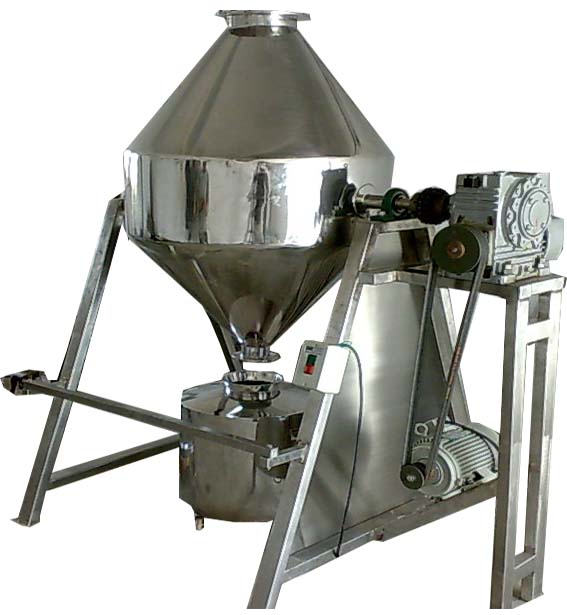double cone blender, powder mixer Product Name: Double Cone Blender
Total Volume(Liter): 25-3000
Double cone blender Application: pharmaceuticals, foods, chemicals, fertilizers, plastics, pigments, cosmetics, powder material

The double cone blender is used to produce homogeneous solid-solid mixture. Mixing is a common process step in the manufacture of products for industries such as healthcare, food, chemical, cosmetics, detergents, fertilizers and plastics.
Examples of materials or substances mixed in this way include pharmaceutical granules, semolina flour, seeds, starch, coffee beans and ground coffee, cocoa, chocolate flakes or granules, powdered milk, baby food, preparations to make dehydrated soups and creams, leaf waxes, detergent granules, soap flakes, artificial fertilizers, plastic in powder, ground or pellet form, fibreglass, etc.
Double Cone Blender Operating principle
The main body of the blender consists of two cone-shaped sections welded at their bases to a central cylindrical section. The axis of rotation is perpendicular to the cone axis and passes through the cylindrical section. The driving motor is located at one of the two lateral supports holding the blender body.
The solids are introduced into the blender through the loading aperture. In this type of blender, mixing takes place axially, as a result of the powder moving through the different sections. Mixing is thorough but it depends on the rotating speed.
The mixture is discharged through a hermetically closing butterfly valve which can be operated manually or automatically.
The unit is provided with a guard rail with electrical safety to prevent the operator from accessing it when in operation. If anyone should gain access to the unit, for safety reasons, the operation will cease.
Double Cone Blender -Design and features
The series consists of 6 models with a total capacity of 25 to 3000 litres and a useful capacity of 65% of the total.
This blender is especially designed for sensitive mixtures with risk of breakage where the generation of dusts is to be avoided.
Mixing times vary between 5 and 20 minutes depending on the mixture.
The interior of the blender incorporates a cone mounted on the pivot axis on both sides. This system eliminates the formation of dead spaces and facilitates gravity discharge.
The unit is manufactured in AISI 316 (EN 14404) quality for all parts in contact with the product and AISI 304 (EN 14301) for the supports and the rest of the equipment. The internal and external surfaces have a bright polished finish. Due to the polished surface and absence of edges or corners, the unit can be easily cleaned either manually or automatically with CIP system.
The unit incorporates a guard rail with electrical safety, according to EC safety standards.
Materials
Parts in contact with the product AISI 316 (EN 14404)
Structure and other metal parts AISI 304 (EN 14301)
Internal finish Bright polish
External finish Bright polish
Options
This unit allows the incorporation of a liquid spray system to introduce liquids in spray form during the process. The injector is connected to the spray nozzles by means of a rotary system and is fed with additives from a pressurized tank or by means of a variable displacement pump at constant pressure.
The automatic stop positions are: loading, discharging, and sampling. Before stopping at one of these three positions, the system performs a cycle which slows down the mixer in order to reach the stopping position with the highest possible accuracy and remains halted at that point.
The unit can be equipped with an automated loading system for introducing powders and granules into the blender body by means of a vacuum unit with self-cleaning hoses. It prevents creation of dust.
The skid can also be provided with a complete mono block vacuum unit with liquid ring pump.
It is possible to install an automated vacuum discharge system. It includes a product receiving hopper with an automated
self-cleaning filter; as well as a control panel for the unit.
The loading/discharge can be carried out with pneumatically actuated retractable hermetic bellows. This system and the vacuum loading/discharge can be combined.
Working Principle
Double Cone Blenders are most often used for dry blending of free flowing solids. The solids being blended in these units can vary in bulk density and in percentage of the total mixture. Materials being blended are constantly being intermixed as the Double Cone rotates. Normal cycle times are typically in the range of 10 minutes, however they can be less depending on the difficulty of blending.
